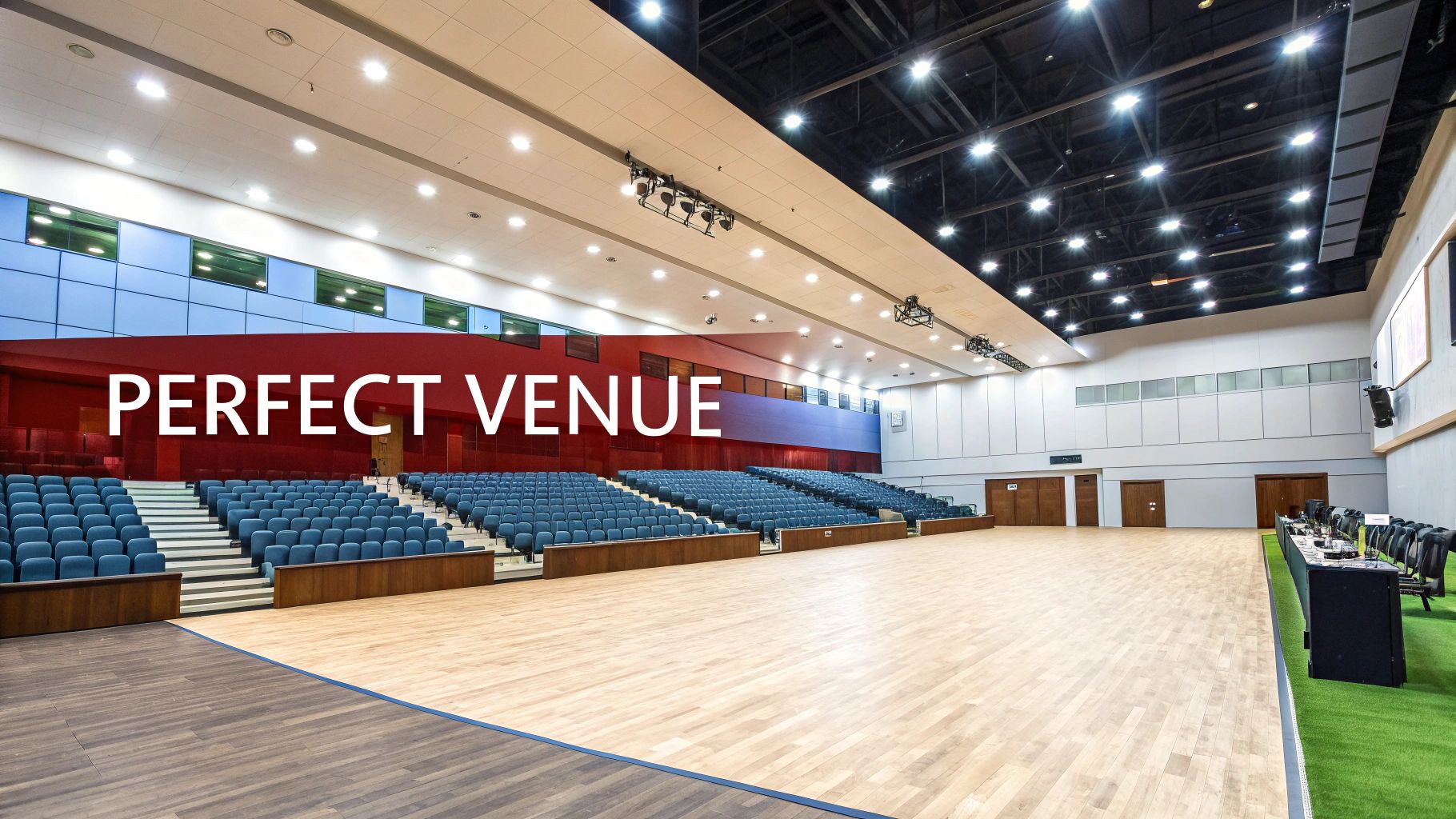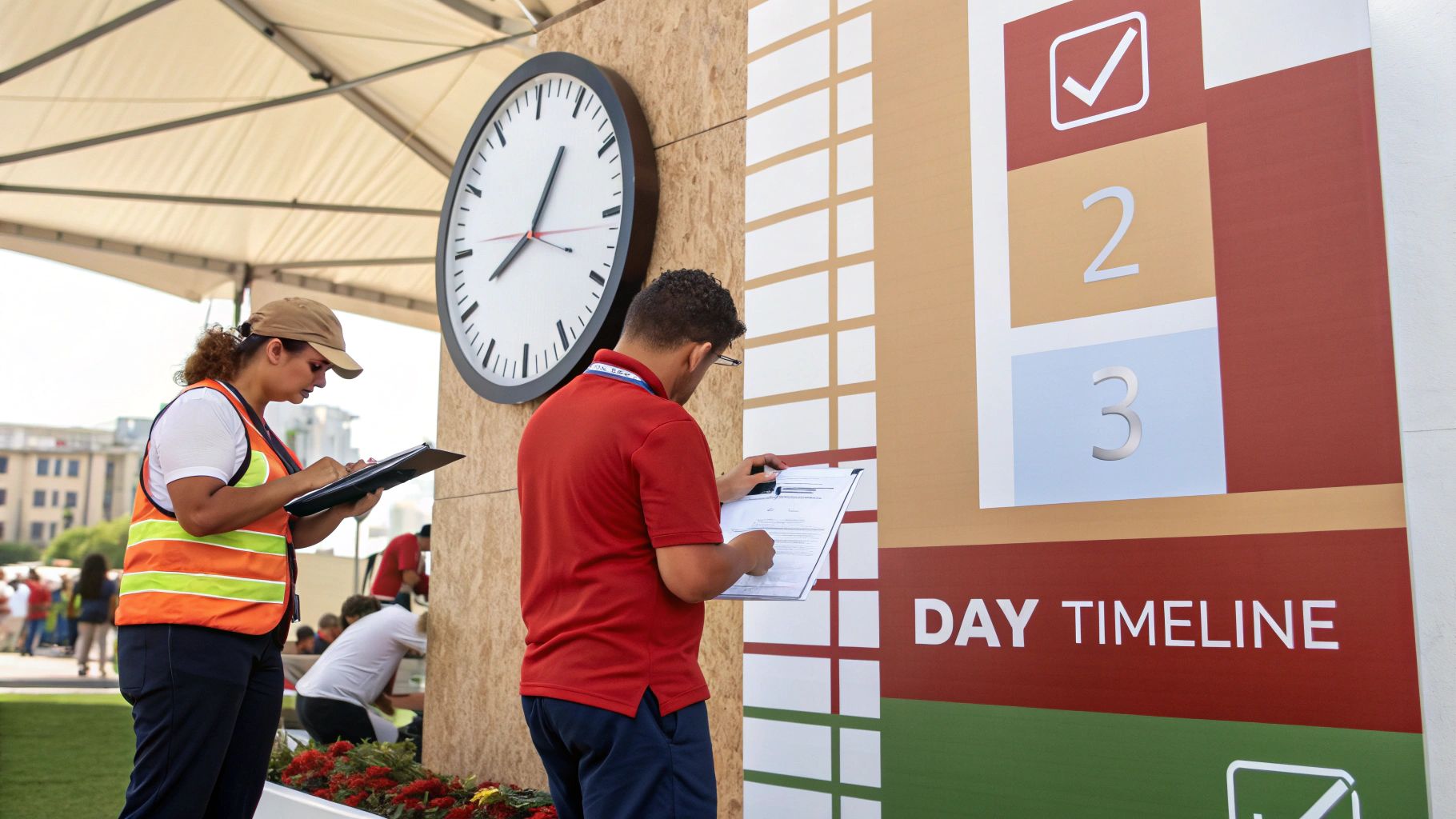Planning a corporate event can feel like orchestrating a complex symphony, with countless moving parts that must harmonize perfectly. From high-stakes product launches and annual shareholder meetings to essential team-building retreats, the success of any corporate gathering hinges on meticulous planning and flawless execution. A single overlooked detail can derail the entire experience, impacting brand perception and wasting valuable resources. This is where a comprehensive corporate event planning checklist becomes your most valuable asset. It transforms an overwhelming task into a manageable, step-by-step process, ensuring no detail is forgotten and every objective is met.
This guide provides a detailed 10-step roundup, moving beyond generic advice to offer actionable strategies, real-world examples, and expert tips. You will learn to define clear goals, manage budgets effectively, select the perfect venue, and execute a flawless event day timeline. The process of establishing these foundational elements is as crucial as building a digital presence; for comprehensive guidance on setting up the foundational elements of your event, much like creating a detailed blueprint, explore an ultimate guide to website planning from concept to launch.
Our checklist is designed for event coordinators, marketing teams, and anyone tasked with delivering a professional, polished event. It will empower you to deliver memorable, impactful experiences that resonate with attendees, from Fortune 100 executives to tech startup teams, and deliver measurable return on investment. Let's dive into the essential components of a truly successful corporate event.
1. Define Event Objectives and Success Metrics
Before a single venue is scouted or a speaker is booked, the most critical step in any corporate event planning checklist is defining what success looks like. This foundational stage involves establishing clear, measurable goals that align directly with broader business strategies. Without this clarity, your event becomes a collection of activities rather than a strategic tool, making it impossible to measure return on investment (ROI).

The primary purpose of your event dictates every subsequent decision. Is it a product launch designed to generate media buzz and secure pre-orders? Or is it an internal sales kickoff aimed at boosting team morale and aligning on quarterly targets? Each goal requires a different approach to content, marketing, and execution.
How to Implement and Set Metrics
The key is to move from abstract goals like "increase engagement" to specific, measurable Key Performance Indicators (KPIs). This process, often championed by organizations like Meeting Professionals International (MPI), ensures accountability and provides a clear benchmark for success.
- Quantitative Metrics: These are the hard numbers. Examples include a 20% increase in qualified leads generated, 150 one-on-one meetings booked between sales reps and prospects, or a 90% session attendance rate.
- Qualitative Metrics: These measure sentiment and perception. Use post-event surveys to gauge attendee satisfaction (e.g., achieve an average session rating of 4.5 out of 5) or track social media sentiment analysis.
For example, Google I/O is laser-focused on developer engagement. Its success isn't just ticket sales; it's measured by the number of developers who adopt new APIs, the volume of technical questions answered in breakout sessions, and the overall buzz generated within the developer community.
Actionable Tips for Objective Setting
To ensure your objectives are robust and serve the business, follow these best practices:
- Involve Stakeholders Early: Host a kickoff meeting with leaders from sales, marketing, product, and finance to gain consensus on the event's primary purpose.
- Document Everything: Create a formal event strategy document that outlines each objective and its corresponding KPI. This document should be the north star for your entire planning team.
- Review and Refine: Objectives are not set in stone. Revisit them at key planning milestones (e.g., after securing a venue, after launching registration) to ensure they remain relevant and achievable.
2. Budget Planning and Financial Management
With your objectives defined, the next critical element in your corporate event planning checklist is creating a comprehensive budget. This isn't just a spreadsheet of expenses; it's a strategic financial plan that ensures every dollar spent contributes directly to your event goals and maximizes return on investment (ROI). Effective financial management is the backbone of your event, preventing cost overruns and enabling smart, impactful decisions.

Your budget will dictate the scale and scope of everything from venue selection and catering to technology and marketing outreach. It provides the realistic constraints within which your creative vision must operate. A well-managed budget empowers you to allocate resources effectively, ensuring that high-priority items receive the funding they need to succeed without compromising the entire event's financial health.
How to Implement and Set Metrics
Building a detailed, line-item budget is non-negotiable. Following best practices from organizations like the Professional Convention Management Association (PCMA), this involves breaking down all potential costs and tracking them meticulously. Your budget should be a living document, updated in real-time as quotes are received and contracts are signed.
- Fixed Costs: These are expenses that remain the same regardless of attendee numbers, such as venue rental, speaker fees, and AV equipment packages.
- Variable Costs: These costs fluctuate with the number of attendees. Key examples include catering (per-person cost), printed materials, and attendee welcome gifts.
For instance, the Adobe Summit famously allocates a significant portion of its budget, around 40%, to technology and production to create an immersive digital experience. In contrast, corporate retreats may allocate over 35% to venue and accommodation to prioritize attendee comfort and environment.
Actionable Tips for Budget Management
To maintain control and maximize your event's financial efficiency, integrate these practices:
- Get Multiple Quotes: For major expenses like venue, AV, and catering, always source at least three competitive bids to ensure fair market pricing.
- Build a Contingency Fund: Earmark 15-20% of your total budget for unforeseen costs. This buffer prevents last-minute scrambles and protects your core event elements. For a detailed breakdown, you can use a comprehensive event budget planning template to stay on track.
- Leverage Technology: Use event management software with built-in budget tracking tools to monitor spending against your plan in real-time and generate financial reports for stakeholders.
- Negotiate Payment Terms: Work with vendors to establish payment schedules that align with your company's cash flow, avoiding large upfront payments where possible.
3. Venue Selection and Logistics Coordination
Once your objectives are set and your budget is framed, the next critical task in your corporate event planning checklist is securing the right venue. The physical space is more than just a backdrop; it shapes the attendee experience, reinforces your brand message, and dictates logistical feasibility. The ideal venue aligns perfectly with your event goals, capacity needs, and budget, acting as a powerful tool in achieving your desired outcomes.

Whether you need a high-tech auditorium for a product launch or an intimate, sophisticated space for an executive retreat, the venue sets the tone. An ill-fitting location can lead to poor attendance, technical failures, and a disconnect between your message and the environment. Therefore, this decision requires careful evaluation beyond just cost and availability.
How to Implement and Set Metrics
The selection process should be a systematic evaluation, not a gut feeling. Platforms like Cvent have professionalized this by allowing planners to compare venues based on detailed criteria. Your evaluation should be rooted in the objectives defined in step one.
- Capacity and Layout: Ensure the venue can comfortably accommodate your target number of guests in the desired format (e.g., theater-style, banquet, classroom). Request detailed floor plans and capacity charts for different setups.
- Technical Infrastructure: Confirm the availability and quality of Wi-Fi, A/V equipment, and power sources. High-speed internet is non-negotiable for most modern corporate events, so verify bandwidth capabilities.
- Accessibility and Location: The venue must be easily accessible for all attendees, including those with disabilities. Consider proximity to airports, public transportation, and hotels.
For example, Apple often builds custom event spaces like the Steve Jobs Theater for its product launches to control every environmental detail. In contrast, Berkshire Hathaway opts for massive convention centers to accommodate its thousands of shareholders, prioritizing scale and accessibility above all else.
Actionable Tips for Venue Selection
To avoid common pitfalls and secure a location that enhances your event, follow these best practices:
- Conduct In-Person Site Visits: A virtual tour is a good start, but nothing replaces seeing the space in person. If possible, visit while a similar event is happening to observe flow, acoustics, and staffing.
- Negotiate Contract Terms: Don't just accept the standard agreement. Push for flexibility on key terms like attrition rates, cancellation policies, and food and beverage minimums.
- Clarify Vendor Policies: Some venues have exclusive or preferred vendor lists. Understand these restrictions early, as they can significantly impact your budget and creative control.
- Check for Hidden Costs: Ask for a complete breakdown of potential fees, including charges for security, cleaning, corkage, and overtime, to ensure they fit within your budget.
4. Guest List Management and Registration System
Beyond the venue and agenda, the success of your corporate event hinges on who attends and how seamlessly they can confirm their participation. Strategic guest list management and a robust registration system are crucial components of any corporate event planning checklist. This involves carefully curating your audience, managing invitations, and deploying technology that makes RSVPing and check-in effortless.

The composition of your audience directly impacts the achievement of your event objectives. A product launch needs influential press and key customers, while a user conference requires engaged power users. A poorly managed guest list can lead to a misaligned audience, while a clunky registration process creates a poor first impression and can deter attendance.
How to Implement and Set Metrics
The goal is to move from a simple headcount to a strategic, data-driven approach. Event technology companies like Cvent and Bizzabo have popularized platforms that integrate guest list management with sophisticated registration and analytics.
- Audience Segmentation: Divide your potential attendees into tiers. For example, Tier 1 could be VIPs (keynote speakers, C-suite executives), Tier 2 could be high-value clients, and Tier 3 could be general attendees. This allows for targeted communication and personalized experiences.
- Registration Funnel Metrics: Track the conversion rate from invitation sent to registration completed. Aim for a high completion rate, and analyze drop-off points to identify friction in the process. Monitor registration numbers against venue capacity to manage expectations and waitlists effectively.
For instance, LinkedIn often hosts industry-specific networking events. They use their own platform's data to meticulously segment invitees by job title, industry, and company size, ensuring the room is filled with precisely the right professionals for high-value networking.
Actionable Tips for Registration Success
To ensure a smooth and effective registration experience, follow these best practices:
- Test Everything Thoroughly: Before going live, conduct multiple tests of the registration flow on different devices (desktop, mobile, tablet) and browsers. Check for broken links, form errors, and payment gateway issues.
- Send Immediate Confirmations: Automate a detailed confirmation email that is sent the moment an attendee completes registration. It should include event details, a QR code for check-in, and links to add the event to their calendar.
- Leverage Registration Data: Use the information collected during registration (e.g., dietary needs, session preferences, company role) to personalize the event experience, from custom agendas to tailored networking suggestions.
5. Catering and Menu Planning
Food and beverage are far more than just sustenance at a corporate event; they are a critical component of the attendee experience that can facilitate networking, reinforce brand values, and energize participants. A well-executed catering strategy moves beyond basic meal service to become a memorable highlight. This part of your corporate event planning checklist requires careful consideration of your audience, event schedule, and overarching goals.
The choice of menu, service style, and even the timing of meals can directly impact the flow and energy of your event. For instance, a heavy, sit-down lunch may lead to a lethargic afternoon session, whereas light, brain-food-focused grazing stations can keep attendees alert and engaged. Your catering should be a thoughtful extension of the event's purpose.
How to Implement and Set Metrics
Effective menu planning involves a proactive and detailed approach to understanding attendee needs and logistical constraints. Success is measured not just by the absence of complaints but by positive feedback, smooth service flow, and minimal food waste.
- Proactive Dietary Management: The most crucial step is to collect dietary restrictions and preferences during the registration process. This data allows your caterer to plan accurately, preventing last-minute scrambles and ensuring every guest feels valued.
- Service Style Alignment: Match the service style to your event's objectives. Buffet-style or food stations encourage mingling and networking, while a formal plated dinner is better suited for awards ceremonies or keynote addresses.
- Sustainability as a Metric: Track and aim to minimize food waste. Work with caterers who partner with food donation programs or have strong composting protocols.
For example, tech conferences often feature "brain food" menus with healthy, energy-boosting options like lean proteins, complex carbs, and fresh juices to keep attendees sharp for technical sessions. Similarly, Google events are known for prioritizing locally-sourced, sustainable menu options that reflect the company's commitment to corporate responsibility.
Actionable Tips for Menu Planning
To ensure your catering enhances the event experience, follow these best practices:
- Survey and Over-Plan: Use your registration form to ask about dietary needs (vegan, vegetarian, gluten-free, allergies). Plan for at least 10% more special meals than requested to accommodate undeclared needs.
- Label Everything Clearly: All food items, especially on a buffet, should be clearly labeled with major ingredients and common allergens (e.g., "Contains Nuts," "Dairy-Free," "Vegan").
- Time Meals Strategically: Schedule meals and coffee breaks to avoid conflicts with key presentations. Ensure break times are long enough for guests to eat, use facilities, and network without feeling rushed.
- Incorporate Local Flavors: For international or destination events, incorporating local cuisine provides a unique and authentic experience for attendees, making the event more memorable.
6. Technology and AV Requirements
In today’s digitally-driven world, the technical execution of an event is as crucial as its content. Flawless audio-visual (AV) delivery, reliable internet, and engaging technological integrations are no longer luxuries but expectations. This step in the corporate event planning checklist involves a meticulous audit and coordination of all technical components to ensure a seamless and professional experience for both presenters and attendees.
From crystal-clear sound systems and dynamic lighting to high-definition projection and robust Wi-Fi, every element must work in harmony. A single technical glitch, like a microphone failure or a lagging live stream, can instantly undermine the event's credibility and distract from its core message. Proper planning prevents these issues and enhances attendee engagement.
How to Implement and Set Metrics
The goal is to move from a simple list of equipment to a comprehensive tech strategy. This involves collaborating with professional AV production companies like Freeman or PSAV to ensure every technical need is identified and met. Success is measured not just by the absence of failures but by the enhancement of the overall event experience.
- Quantitative Metrics: These measure reliability and usage. Examples include zero instances of technical failure during main stage presentations, achieving 99.9% uptime for the event live stream, or ensuring Wi-Fi network latency remains below 100ms even at peak capacity.
- Qualitative Metrics: These gauge the attendee experience with the technology. Post-event surveys can ask attendees to rate the audio and visual quality on a scale of 1-5 or provide feedback on the ease of use of the event app.
For example, TED Talks have set the global standard for presentation AV. Their success is defined by flawless audio capture, perfect lighting that focuses on the speaker, and crisp visual aids, creating an immersive experience that feels intimate whether viewed in-person or online.
Actionable Tips for Tech Planning
To guarantee a technically sound event, integrate these best practices into your workflow:
- Conduct a Full Tech Rehearsal: Go beyond a simple soundcheck. Run through every presentation, video cue, and transition with the actual presenters and equipment in the event space at least one day prior.
- Test All Presenter Devices: Have every speaker connect their laptop or device to the projection and sound system well before their scheduled slot to resolve any compatibility issues.
- Plan for Redundancy: Always have backup systems for critical components. This includes spare microphones, projectors, laptops with pre-loaded presentations, and even a secondary internet connection.
- Assign Dedicated Support: Ensure a dedicated AV technician is present for every session, especially in main halls and key breakout rooms, to address any issues immediately.
7. Marketing and Communication Strategy
A world-class event is ineffective if no one knows it's happening. A robust marketing and communication strategy is the engine that drives attendance, generates buzz, and ensures your event's message reaches the right audience. This element of your corporate event planning checklist moves beyond simple announcements to create a comprehensive promotional narrative that engages attendees before, during, and after the event.
This strategy dictates how you build anticipation, communicate value, and maintain momentum. It’s the difference between a sparsely attended conference and a sold-out summit that dominates industry conversations. Your plan should encompass email marketing, social media campaigns, public relations, content creation, and partner promotions.
How to Implement and Set Metrics
Successful event marketing, championed by platforms like Bizzabo and Splash, relies on a multi-channel approach with clear KPIs. The goal is to create a seamless journey that guides a potential attendee from awareness to registration and, finally, to active participation.
- Pre-Event Marketing: Focus on driving registrations and building excitement. Metrics include email open rates, click-through rates on registration links, social media engagement rates, and website traffic from promotional sources.
- Post-Event Communication: The goal is to extend the event's lifecycle and nurture leads. Track metrics like on-demand content views, post-event survey completion rates, and the number of leads passed to sales. To maximize the impact of your event marketing, exploring modern strategies for video lead generation can significantly boost your post-event ROI.
For instance, Salesforce's Dreamforce excels at this by generating massive pre-event hype through early-bird offers and speaker announcements. Its social media engagement and media coverage are legendary, making it a can't-miss event in the tech world.
Actionable Tips for Marketing and Communication
To ensure your promotional efforts deliver maximum impact, integrate these best practices:
- Create a Unique Hashtag: Develop a simple, memorable hashtag (e.g., #Dreamforce23) and promote it across all channels to consolidate social conversations and encourage user-generated content.
- Leverage Employee Networks: Encourage your team to act as brand ambassadors by sharing event updates on their professional networks like LinkedIn. This provides authentic, organic promotion.
- Develop Compelling Content: Go beyond basic event details. Create blog posts, speaker interview videos, or behind-the-scenes content that showcases the unique value and experience attendees can expect. You can discover more on this by exploring an event marketing strategy template on electronicfinishing.solutions.
8. Speaker and Content Coordination
The content delivered at your event is its heart and soul, and the speakers are the vessels who bring it to life. Effective speaker and content coordination is a detailed process that involves much more than just booking a name. It's about strategically aligning your speakers' expertise with your event objectives to create a cohesive, impactful narrative that resonates with your audience. This step in the corporate event planning checklist ensures every session contributes directly to the event's overall goals.
This process covers everything from initial recruitment and contract negotiation to content development, technical rehearsals, and on-site management. A poorly managed speaker experience can lead to misaligned messaging or technical failures, undermining the entire event's credibility. Conversely, a well-coordinated program elevates the attendee experience and amplifies your key messages.
How to Implement and Manage Content
Success lies in a structured, proactive management approach. This involves creating a clear framework for speaker communication and content delivery, a practice perfected by organizations like the National Speakers Association to ensure professional-grade presentations.
- Speaker Management: This covers the logistical and relational aspects. It includes sourcing and vetting speakers, negotiating fees and contracts, and managing all travel and accommodation logistics. A dedicated speaker liaison is crucial for providing a single point of contact.
- Content Curation: This is the strategic part. It involves defining session topics that align with your event theme, reviewing presentation slides for quality and brand consistency, and ensuring there is no content overlap between different speakers.
For instance, TED Conferences are renowned for their meticulous speaker curation. Speakers undergo months of coaching and rehearsals to refine their "idea worth spreading" into a precise, powerful 18-minute talk. This rigorous process guarantees the high-quality, thought-provoking content the brand is known for.
Actionable Tips for Speaker Coordination
To ensure a seamless and professional speaker program, integrate these best practices into your workflow:
- Book Speakers Early: Secure keynote speakers 6-12 months in advance for major events and breakout session speakers at least 3-6 months out. Always identify backup speakers in case of last-minute cancellations.
- Provide a Speaker Packet: Create a comprehensive guide with all key information: presentation guidelines (format, timing), technical specs, event schedule, travel details, and key contact information.
- Schedule Technical Rehearsals: Never leave A/V to chance. Mandate a pre-event technical check with each speaker to test their presentation, microphone, and internet connection, especially for virtual or hybrid formats.
- Facilitate Pre-Event Briefings: Host a call between key organizers and speakers to align on messaging, audience expectations, and the specific role their session plays in the overall event journey.
9. Event Day Timeline and Staff Coordination
Even the most meticulously planned event can falter without a precise execution plan for the day itself. This is where a detailed, minute-by-minute timeline and robust staff coordination become indispensable parts of any corporate event planning checklist. This stage moves beyond strategic planning into tactical, on-the-ground execution, ensuring every element unfolds seamlessly from setup to breakdown.
The core principle is to leave nothing to chance. Your timeline, often called a "run of show," should detail every action, cue, and transition. This document is the master script for your entire team, from the A/V technicians to the registration staff, aligning everyone on a single, synchronized plan.
How to Implement and Set Metrics
Implementation requires granular detail and clear communication channels. The goal is to anticipate needs and create a command structure that can react swiftly to any unexpected issues. A successful timeline isn't just a schedule; it's a dynamic operational guide.
- Minute-by-Minute Scheduling: Document everything from vendor arrival and setup times to speaker walk-on cues, meal service, and session transitions. Don't just list "Lunch at 12 PM"; specify "11:45 AM - Catering final check," "12:00 PM - Buffet lines open," and "12:10 PM - Welcome announcement in dining hall."
- Role-Specific Assignments: Create tailored versions of the master timeline for different teams. The A/V crew needs to know about sound checks and presentation cues, while the hospitality team needs to focus on attendee flow and F&B schedules. Assign a clear point person for each functional area (e.g., Registration Lead, A/V Lead).
For example, the Olympic Games opening ceremonies represent the pinnacle of timeline coordination. Every firework, performer entrance, and broadcast cue is timed to the second across multiple teams and locations, a feat achieved through military-style logistical planning and extensive rehearsals.
Actionable Tips for Timeline Coordination
To ensure flawless event-day execution, adopt these best practices used by professional event management firms:
- Build in Buffer Time: Never schedule back-to-back with no margin for error. Add 5-10 minute buffers between key segments like sessions or before major keynote speeches to absorb minor delays without derailing the entire schedule.
- Conduct a Full Dress Rehearsal: When possible, especially for high-stakes presentations or complex productions, run through the entire program with key staff and speakers. This uncovers technical glitches and logistical friction points. For more information on preparing your team, explore these valuable event planning checklist template resources.
- Use Real-Time Communication Tools: Equip your team leads with a dedicated communication channel like a Slack channel or walkie-talkies. This allows for instant updates and problem-solving without disrupting the event flow.
10. Post-Event Follow-up and ROI Measurement
The work on your corporate event planning checklist isn't finished when the last attendee leaves. In fact, the post-event phase is where you secure the event's long-term value and prove its return on investment (ROI). This crucial stage involves systematically gathering feedback, nurturing new relationships, and analyzing data to quantify success against the objectives set in step one. Neglecting this follow-up is like running a race and stopping just before the finish line; the true impact is never realized.
This process transforms a one-time event into a sustained campaign. It's about capitalizing on the momentum generated, whether that means converting leads, reinforcing internal training, or improving employee satisfaction. A well-executed follow-up strategy demonstrates professionalism and ensures the event contributes meaningfully to broader business goals.
How to Implement and Measure ROI
Effective follow-up relies on speed, segmentation, and data analysis, a practice perfected by marketing automation platforms like HubSpot and Marketo. The goal is to connect your event activities directly to business outcomes, moving beyond simple attendance numbers to measure true impact.
- Lead Nurturing and Sales Attribution: For sales-focused events, track how many leads generated at the event convert into qualified opportunities and, ultimately, closed-won deals. Trade shows often measure this over a 6-12 month sales cycle to capture the full ROI.
- Feedback and Sentiment Analysis: Deploy surveys to gather quantitative data (e.g., Net Promoter Score, session ratings) and qualitative feedback. For an internal corporate retreat, this could mean measuring post-event employee satisfaction scores and tracking their correlation with retention rates over the next two quarters.
- Content Engagement: Analyze which post-event resources (e.g., session recordings, presentation slides, white papers) were downloaded most. This indicates which topics resonated and helps guide future content strategy. HubSpot excels at this, using comprehensive post-INBOUND event nurturing sequences tailored to attendee behavior.
Actionable Tips for Effective Follow-up
To maximize your event's impact, implement a structured post-event communications plan:
- Send Feedback Surveys Promptly: Distribute surveys within 24-48 hours while the experience is still fresh. Keep them short (5-7 questions) and focused on actionable insights to maximize completion rates.
- Segment Your Communications: Don't send a generic "thank you" email. Create tailored follow-up sequences for different attendee segments like prospects, existing customers, VIPs, and no-shows, each with a relevant call-to-action.
- Document Everything: Conduct a thorough post-mortem meeting with all stakeholders. Document key takeaways, successes, failures, and final budget numbers in a report. This becomes an invaluable reference for future event planning.
Corporate Event Planning Checklist Comparison
| Item | Implementation Complexity 🔄 | Resource Requirements ⚡ | Expected Outcomes 📊 | Ideal Use Cases 💡 | Key Advantages ⭐ |
|---|---|---|---|---|---|
| Define Event Objectives and Success Metrics | Medium - requires stakeholder alignment | Moderate - planning sessions | Clear direction, measurable goals, improved evaluation | Strategic and goal-driven events | Provides focus, aligns with business strategy, measurable ROI |
| Budget Planning and Financial Management | High - detailed estimations and monitoring | High - financial expertise and tools | Cost control, maximized ROI, vendor accountability | Any corporate event with budget constraints | Prevents overruns, transparency, facilitates negotiations |
| Venue Selection and Logistics Coordination | Medium - site visits and compliance checks | Moderate - time for assessments | Optimal attendee experience, logistical efficiency | Events where atmosphere and accessibility are priorities | Enhances attendee experience, includes support services |
| Guest List Management and Registration System | Medium - tech integration and testing | Moderate - software and CRM | Streamlined management, personalized communication | Events with varied attendee types and capacity limits | Automates processes, provides valuable data |
| Catering and Menu Planning | Medium - requires dietary and cultural research | Moderate to High - vendor coordination | Enhanced satisfaction, networking facilitation | Events prioritizing attendee comfort and cultural fit | Boosts experience, reflects culture, encourages interaction |
| Technology and AV Requirements | High - technical setup and testing | High - specialized equipment and staff | Professional presentations, audience engagement | Hybrid or large-scale events requiring tech reliability | Enhances quality, expands reach, content repurposing |
| Marketing and Communication Strategy | High - multi-channel coordination | High - content creation and management | Increased attendance, brand awareness, engagement | Events needing strong promotion and brand presence | Builds buzz, drives attendance, supports ongoing marketing |
| Speaker and Content Coordination | Medium to High - scheduling and content vetting | Moderate - coordination and contracts | High-quality content, attracts attendees | Knowledge-sharing and industry expert events | Ensures relevant, engaging presentations, networking opportunities |
| Event Day Timeline and Staff Coordination | High - detailed scheduling and communication | Moderate - staffing and tools | Smooth execution, reduced stress, quick issue resolution | Complex events requiring precise timing and coordination | Ensures order, accountability, effective problem handling |
| Post-Event Follow-up and ROI Measurement | Medium - data collection and analysis | Moderate - survey tools and CRM | Insights for improvement, demonstrated ROI, relationship building | All events aiming for continuous improvement and business impact | Drives future success, validates event value, nurtures leads |
Executing Excellence: Your Final Checklist for Event Success
Navigating the complexities of corporate event planning can feel like conducting a symphony. Each instrument, from budget allocation to post-event analytics, must play its part in perfect harmony to create a masterpiece. This comprehensive corporate event planning checklist has served as your conductor's score, guiding you through every critical movement, from the opening notes of defining your objectives to the final crescendo of measuring your return on investment. The journey from a nascent idea to a flawlessly executed event is built upon the meticulous application of these foundational principles.
By following this detailed roadmap, you have transformed an abstract vision into a tangible, strategic plan. You've learned that a successful event isn't just about a great venue or a memorable keynote speaker; it's the seamless integration of every single component. The true power of this checklist lies in its ability to empower you, the planner, to maintain control and foresight over a dynamic and often unpredictable process.
Synthesizing the Strategy: Core Takeaways for Planners
As you transition from planning to execution, let's distill the most crucial insights from our guide. These are the non-negotiable pillars that will support your event's structure and ensure it stands strong against any challenge.
- Objective-Driven Everything: Your initial goals and KPIs are not just a preliminary step; they are the North Star for every subsequent decision. From the choice of catering to the content of your follow-up emails, every action must directly serve your primary objectives.
- The Budget as a Strategic Tool: View your budget not as a limitation but as a strategic framework. Effective financial management involves more than just tracking expenses; it’s about allocating resources to the areas that will generate the highest impact and deliver the greatest value to your attendees and your organization.
- Experience is the Product: In the world of corporate events, the attendee experience is what you are ultimately delivering. This encompasses everything from the ease of registration and the quality of the audiovisual presentation to the comfort of the seating and the networking opportunities you facilitate.
- Communication is Continuous: Your event marketing and communication strategy doesn't end when registration closes. It's a continuous loop that begins with the first announcement, builds momentum through engaging pre-event content, peaks during the event itself, and continues long after with post-event follow-ups and community building.
From Blueprint to Reality: Your Actionable Next Steps
With your detailed plan in hand, the next phase is about bringing it to life with precision and adaptability. True excellence is found in the execution, where your meticulous preparation meets the real world. Remember, even the most thorough corporate event planning checklist requires a flexible and proactive leader at the helm.
Key Insight: A plan provides the structure, but flexibility provides the resilience. Be prepared to pivot, troubleshoot, and make decisive adjustments on the fly. Your ability to adapt to unforeseen circumstances is just as critical as your ability to plan for the expected ones.
To truly elevate your next event from merely successful to truly unforgettable, consider the tangible touchpoints that leave a lasting impression. Think beyond the digital and consider the physical takeaways that reinforce your brand's message of quality and appreciation. Imagine gifting your VIPs, speakers, or top clients premium, custom-branded technology from iconic brands like Apple, Bose, or Sonos. This isn't just a giveaway; it's a strategic investment in your brand's prestige and a powerful tool for building lasting relationships. By merging a flawless execution plan with high-value, memorable brand extensions, you create an unparalleled experience that resonates long after the final session concludes.
Ready to elevate your event's gifting strategy and leave a lasting impression? Electronic Finishing Solutions specializes in custom-branding premium tech products from the world's most sought-after brands. Discover how you can integrate high-value, branded technology into your next event by visiting Electronic Finishing Solutions.



